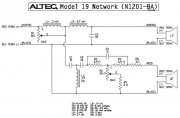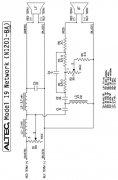- Joined
- Jan 14, 2011
- Messages
- 75,861
- Location
- Gillette, Wyo.
- Tagline
- Halfbiass...Electron Herder and Backass Woof
Me and you both George...
Crossovers are described as having an 'order', 1st order, 2nd order, 3rd, or 4th. The number denotes the strength of the filter, with 1st being the weakest and 4th the strongest. Each of these components (inductors and capacitors) share the same value of filter power. For each octave they will lower the signal by 6dB, (-6dB).Truth is, I understand so little about this stuff that I need a graphic representation to maybe halfway understand a little better. I find electronics to be extremely perplexing. It's nice to be able to see a representation of what's happening.
Thanks Mark. That's a lot typing! My issue is I lack the basics. Like how to measure electrical decibels and have no understanding of vectors. It will come. I'll need to measure decibels when I align the PL1000 S2, so I've been reading up on that. Seems fairly straightforward, I just need to jump in and do it.Crossovers are described as having an 'order', 1st order, 2nd order, 3rd, or 4th. The number denotes the strength of the filter, with 1st being the weakest and 4th the strongest. Each of these components (inductors and capacitors) share the same value of filter power. For each octave they will lower the signal by 6dB, (-6dB).
For example, consider the low pass filter type crossover. You want the low frequencies to pass to the woofer and you want the higher frequencies cancelled. This is done with an inductor.
1 inductor. . . . . . . . . . . . . (which is a 1st order filter) that starts to filter the woofer at 500Hz will then lower 1000Hz by -6dB and lower 2000Hz by -12dB, 4000Hz by -18dB and 8000Hz by -24dB. https://europe-audio.com/crossover_calc.asp?id=16
1 inductor with 1 capacitor (which is a 2nd order filter ) that starts to filter the woofer at 500Hz will then lower 1000Hz by -12dB and lower 2000Hz by -24dB, 4000Hz by -36dB and 8000Hz by -48dB. https://europe-audio.com/crossover_calc.asp?id=27
3rd = 1000-18dB, 2000-36dB, 4000-54dB, 8000-72dB. https://europe-audio.com/crossover_calc.asp?id=28
Then you would do the same with a high pass filter. This allows the high frequencies to pass to the tweeter and the low frequencies get cancelled. This is done with capacitors. https://europe-audio.com/crossover_calc.asp?id=17
Typically a crossover will use a LC (inductor/resistor) network to accomplish a high pass and low pass filter at the same time. How the drivers are wired into the filter determines which one get high frequencies and which one gets low frequencies. https://europe-audio.com/crossover_calc.asp?id=1
The key as Joe says, is that the more components used, the more power is converted to heat, so there is a practical limit. More importantly, there is a factor of sound alteration.
Once the music has passed through the crossover (capacitors and inductors) it emerges with changes to the transients, amplitude time, and phase. Every original key part of the musical structure has been altered or moved from its original position.
For this reason, the best crossover is the First Order Crossover (for each driver) because it outputs a -45 degree vector to the tweeter and a +45 degree vector to the woofer. This is as good as it gets for the drivers, a signal that sums to unity with a combined phase shift of zero.
As with many things in electronics, there is some compromise - to get a good amount of octave attenuation, you may need a Second Order or a Third Order Crossover and give up some phase alignment.
George, there are people who have already done the hard work for us, and we don't need to concern ourselves with the theories unless you want to. Just follow the DIY calculator for the values of capacitors and inductors for the type of crossover you want and order those parts.Like how to measure electrical decibels and have no understanding of vectors.
Funny that you said that. I had the same experience with room rattling using the 15" sub powered by a Crown 600. So I bought a pair of "Bass Shakers" and mounted them to the frame of the sofa. When someone fired a shot, you FELT it.Need just enough too feel the gunshots and thunder.
Mark, those transducers are really interesting. Been thinking about building a cheap, large, liquid, record cleaner using a signal generator, small amp, and a transducer. I've done no research on this, perhaps a future project I'll do.Funny that you said that. I had the same experience with room rattling using the 15" sub powered by a Crown 600. So I bought a pair of "Bass Shakers" and mounted them to the frame of the sofa. When someone fired a shot, you FELT it.
Maybe you can use one of these and build a motorized spindle assembly to support a record vertically in some solution? There are many fluid options, including a photo-flo, isopropyl&distilled water with a drop of dish soap, or any number of commercial record cleaners.Mark, those transducers are really interesting. Been thinking about building a cheap, large, liquid, record cleaner using a signal generator, small amp, and a transducer. I've done no research on this, perhaps a future project I'll do.


Jean Hiraga has designed some great Altec 2 way crossover designsThe original crossovers in my Altec 1202s were not good, I have em tweaked to be a lot better, but ultimately I’m looking into model 19 crossovers and variants there of…..
The Altec 1202 is a PA speaker and has a stronger but less musical 1200Hz crossover. These are like distant cousins to the Altec 19s.The original crossovers in my Altec 1202s were not good, I have em tweaked to be a lot better, but ultimately I’m looking into model 19 crossovers and variants there of…..
